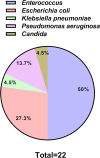Association between platelet to lymphocyte ratio and febrile urinary tract infection after double-J stent removal in children underwent laparoscopic pyeloplasty
- PMID: 40361034
- PMCID: PMC12070569
- DOI: 10.1186/s12894-025-01808-5
Association between platelet to lymphocyte ratio and febrile urinary tract infection after double-J stent removal in children underwent laparoscopic pyeloplasty
Abstract
Objective: To evaluate the association between the inflammatory biomarkers and the prevalence of febrile urinary tract infection (fUTI) after double-J (DJ) stent removal in pediatrics following laparoscopic pyeloplasty (LP).
Methods: A retrospective study was conducted in pediatrics underwent DJ stent removal following LP owing to primary ureteropelvic junction obstruction (UPJO) between September 2021 and November 2024. Baseline characteristics, preoperative data and the incidence of fUTI were documented. The inflammatory index including neutrophil to lymphocyte ratio (NLR), platelet to lymphocyte ratio (PLR) and systemic immune-inflammation index (SII) were calculated. The results of cultured pathogens were also identified. The univariate and multivariate logistic analysis were conducted to determine the potential risk factors of fUTI after DJ stent removal. The predictive value of potential risk factors were determined by receiver operating characteristic curve (ROC).
Results: Overall, 295 patients were included in the study. fUTI occurred in 22 patients (7.5%) after DJ stent removal. Patients in the fUTI group were younger (P = 0.008) and had lower body weight (P = 0.003) compared to non-fUTI group. Additionally, the fUTI group showed higher levels of platelets and neutrophils, associated with lower levels of lymphocytes. The most commonly identified pathogens were Enterococcus and Escherichia coli in fUTI patients. Multivariate logistic analysis revealed that age (OR = 0.978, 95% CI: 0.956-0.999, P = 0.047), toilet training status (OR = 0.297, 95% CI: 0.109-0.807, P = 0.017) and higher levels of PLR (OR = 1.101, 95% CI: 1.005-1.022, P = 0.002) were predictive factors for fUTI after DJ stent removal. PLR had a high predictive value with an AUC of 0.827 with the sensitivity of 90.91% and the specificity of 69.23%.
Conclusion: PLR is a promising predictor for diagnosing fUTI after DJ stent removal. Patients with higher levels of PLR before DJ stent removal should be closely monitored. Further well-designed and prospective cohorts are required in future to explore the cause-and-effect relationship between PLR and fUTI after DJ removal.
Keywords: DJ stent removal; Febrile urinary tract infection; Laparoscopic pyeloplasty; Platelet to lymphocyte ratio; Predictive factor.
© 2025. The Author(s).
Conflict of interest statement
Declarations. Ethics approval and consent to participate: The study protocol has been approved by the Research Ethics Board of Children’s Hospital of Nanjing Medical University (No.202410041) and it conforms to the provisions of the Declaration of Helsinki. Informed consent to participate was obtained from the participants in the study. Consent for publication: Consents for publication were obtained from the participants in the study. Competing interests: The authors declare no competing interests.
Figures




Similar articles
-
Febrile urinary tract infection after Double-J stent removal is associated with restenosis after laparoscopic pyeloplasty: A propensity score matched analysis of 503 children.J Pediatr Urol. 2023 Apr;19(2):200.e1-200.e7. doi: 10.1016/j.jpurol.2022.12.008. Epub 2022 Dec 22. J Pediatr Urol. 2023. PMID: 36599720
-
Outcomes and costs analysis of Externalized PyeloUreteral versus internal Double-J ureteral stents after paediatric laparoscopic Anderson-Hynes pyeloplasty.J Pediatr Urol. 2021 Apr;17(2):232.e1-232.e7. doi: 10.1016/j.jpurol.2020.12.006. Epub 2020 Dec 8. J Pediatr Urol. 2021. PMID: 33388262
-
Primary pyeloplasty for uretero-pelvic obstruction in the USA adult population with or without double-J indwelling ureteral stents. Insurance claims data on contemporary time to removal trends, perioperative complications, health care costs, and re-intervention rates.Minerva Urol Nephrol. 2024 Oct;76(5):606-617. doi: 10.23736/S2724-6051.24.05834-8. Minerva Urol Nephrol. 2024. PMID: 39320251
-
Comparison of DJ stented, external stented and stent-less procedures for pediatric pyeloplasty: A network meta-analysis.Int J Surg. 2019 Aug;68:126-133. doi: 10.1016/j.ijsu.2019.07.001. Epub 2019 Jul 4. Int J Surg. 2019. PMID: 31279854 Review.
-
Pyeloplasty with ureteral stent placement in children: Do prophylactic antibiotics serve a purpose?J Pediatr Urol. 2022 Dec;18(6):804-811. doi: 10.1016/j.jpurol.2022.03.022. Epub 2022 Apr 11. J Pediatr Urol. 2022. PMID: 35501240 Review.
References
-
- Nguyen HT, Herndon CD, Cooper C. The society for fetal urology consensus statement on the evaluation and management of antenatal hydronephrosis. J Pediatr Urol. 2010;6(3):212–31. 10.1016/j.jpurol.2010.02.205. - PubMed
-
- Penn HA, Gatti JM, Hoestje SM. Laparoscopic versus open pyeloplasty in children: preliminary report of a prospective randomized trial. J Urol. 2010;184(2):690–5. 10.1016/j.juro.2010.03.062. - PubMed
-
- Mei H, Pu J, Yang C. Laparoscopic versus open pyeloplasty for ureteropelvic junction obstruction in children: a systematic review and meta-analysis. J Endourol. 2011;25(5):727–36. 10.1089/end.2010.0544. - PubMed
MeSH terms
Substances
LinkOut - more resources
Full Text Sources
Medical

